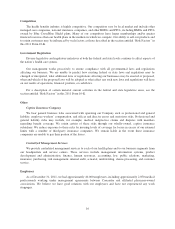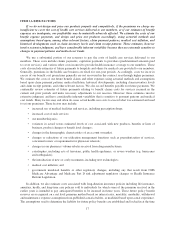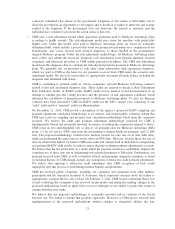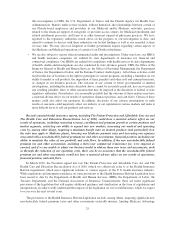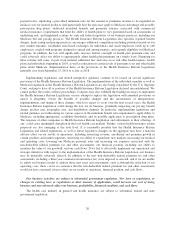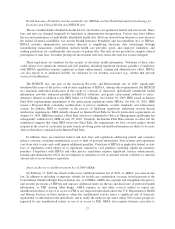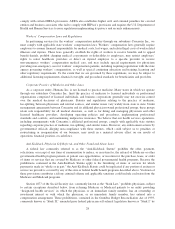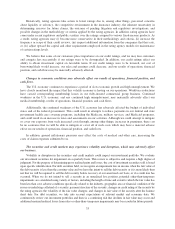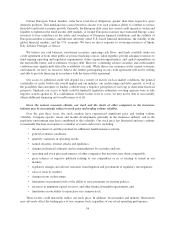Humana 2011 Annual Report Download - page 34
Download and view the complete annual report
Please find page 34 of the 2011 Humana annual report below. You can navigate through the pages in the report by either clicking on the pages listed below, or by using the keyword search tool below to find specific information within the annual report.inconsistency issues described above, it would have a material adverse effect on our revenues derived
from the Medicare Advantage program and, therefore, our results of operations, financial position, and
cash flows.
• Our CMS contracts which cover members’ prescription drugs under Medicare Part D contain
provisions for risk sharing and certain payments for prescription drug costs for which we are not at
risk. These provisions, certain of which are described below, affect our ultimate payments from CMS.
The premiums from CMS are subject to risk corridor provisions which compare costs targeted in our
annual bids to actual prescription drug costs, limited to actual costs that would have been incurred
under the standard coverage as defined by CMS. Variances exceeding certain thresholds may result in
CMS making additional payments to us or require us to refund to CMS a portion of the premiums we
received (known as a “risk corridor”). We estimate and recognize an adjustment to premiums revenue
related to the risk corridor payment settlement based upon pharmacy claims experience. The estimate
of the settlement associated with these risk corridor provisions requires us to consider factors that may
not be certain, including member eligibility differences with CMS. Our estimate of the settlement
associated with the Medicare Part D risk corridor provisions was a net payable of $329 million at
December 31, 2011.
Reinsurance and low-income cost subsidies represent payments from CMS in connection with the
Medicare Part D program for which we assume no risk. Reinsurance subsidies represent payments for
CMS’s portion of claims costs which exceed the member’s out-of-pocket threshold, or the catastrophic
coverage level. Low-income cost subsidies represent payments from CMS for all or a portion of the
deductible, the coinsurance and co-payment amounts above the out-of-pocket threshold for low-income
beneficiaries. Monthly prospective payments from CMS for reinsurance and low-income cost subsidies
are based on assumptions submitted with our annual bid. A reconciliation and settlement of CMS’s
prospective subsidies against actual prescription drug costs we paid is made after the end of the year.
Settlement of the reinsurance and low-income cost subsidies as well as the risk corridor payment is
based on a reconciliation made approximately 9 months after the close of each calendar year. This
reconciliation process requires us to submit claims data necessary for CMS to administer the program.
Our claims data may not pass CMS’s claims edit processes due to various reasons, including
discrepancies in eligibility or classification of low-income members. To the extent our data does not
pass CMS’s claim edit processes, we may bear the risk for all or a portion of the claim which otherwise
may have been subject to the risk corridor provision or payment which we would have otherwise
received as a low-income or reinsurance claim. In addition, in the event the settlement represents an
amount CMS owes us, there is a negative impact on our cash flows and financial condition as a result
of financing CMS’s share of the risk. The opposite is true in the event the settlement represents an
amount we owe CMS.
• The Budget Control Act of 2011, enacted on August 2, 2011, increased the United States debt ceiling
conditioned on deficit reductions to be achieved over the next ten years. The Budget Control Act of 2011
also established a twelve-member joint committee of Congress known as the Joint Select Committee on
Deficit Reduction to propose legislation to reduce the United States federal deficit by $1.5 trillion for
fiscal years 2012-2021. The failure of the Joint Select Committee on Deficit Reduction to achieve a
targeted deficit reduction by December 23, 2011 triggered an automatic reduction, including aggregate
reductions to Medicare payments to providers of up to 2 percent per fiscal year. At this time it is unclear
how this automatic reduction may be applied to various Medicare healthcare programs or the timing when
such reductions may begin. We expect that if such reductions were to occur, there would be a
corresponding substantial reduction in our obligations to providers. Due to the uncertainty around the
timing or application of any such reductions, there can be no assurances that we could completely offset
any reductions to the Medicare healthcare programs applied by the Budget Control Act of 2011.
• With the assistance of outside counsel, we are conducting an ongoing internal investigation related to
certain aspects of our Florida subsidiary operations, and have voluntarily self-reported the existence of
24




